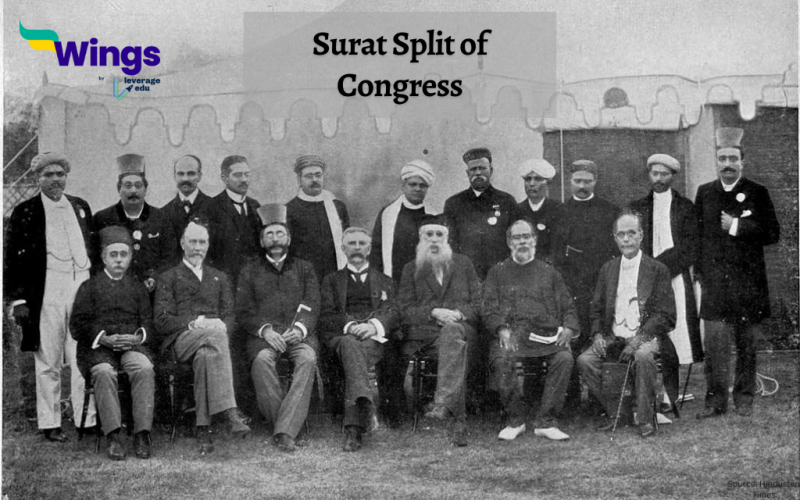The Surat Split refers to the split in the Indian National Congress (INC) at the Surat session in 1907. The split between the extremists and the moderates reached its conclusion because of the difference in the ideology of the two fractions. On one hand, the Moderates maintained that the best way to protest was through the means of dialogues, constitutional agitation, petitions, and protests. On the other hand, the extremists believed and advocated more radical methods of protests. In this blog, we will explore the reasons behind the Surat Split, the history, aftermath, etc.
Also Read: Formation of the Indian National Congress (1885)
Table of Contents
Background of Surat Split
The moderates dominated the Indian National Congress during the years 1885-1905, using pamphlets, leaflets, diplomatic dialogues, meetings etc as a means of presenting their demands form the British Government. However, there was a growing dissatisfaction amongst the people as the diplomatic methods did not get much results. The most notable achievement was the expansion on the expansion of the legislative council by the Indian Councils Act of 1892.
While the extremists wanted Bal Gangadhar Tilak to become the president of the Indian National Congress, the moderates were in favor of Rash Bihari Ghosh. Due to the growing differences between the two fractions, an INC meeting was going to be held in the year 1907 in Nagpur. However, the meeting was moved by Gopal Krishna Gokhale to Surat, allegedly with a fear that Bal Gangadhar Tilak would win there. Bal Gangadhar Tilak could not preside over the meeting as Surat was situated in his home province. Moreover, he was not even given permission to speak which outraged the extremists, and that led to a violent squabble between the two fractions. The groups made up for their differences for a year, but in 1907 they split permanently.
Also Read: All About Civil Disobedience Movement
Main Pointers on Surat Split
Following are the main pointers on the Surat Split
- The Indian National Congress split into two fractions based on the ideology
- The British government seeing this, started implementing repressive measures against many leaders of freedom struggle. They used the divide-and-rule policy to further create a rift between the two parties.
- New tactics of protests against the British government emerged
- The annual session of 1907 in the Indian National was seen as a dark hour of Indian Politics.
Also Read: Pandit Motilal Nehru: Life and Contribution
Effects of Surat Split
Some of the effects of the Surat split included the introduction of Swaraj in the Indian National Congress at the INC’s Banaras Session in 1905. This was introduced by Gokhale who was the President of the INC at that time. In the year 1907, two important objectives were put forward in the Surat Session by the Extremists. They demanded the presidency of Lala Lajpat Rai and the resolution of Swaraj. However, these objectives were not accepted by the Moderates as they supported Rash Behari Ghosh. Thus, elections were held, for the first time, for the president of the Indian National Congress.
Ultimately, the Moderates expelled the extremists from the INC and thus got complete control of the affairs of Congress.
FAQs
While the extremists wanted Bal Gangadhar Tilak to become the president of the Indian National Congress, the moderates were in favour of Rash Bihari Ghosh. The growing differences, especially in terms of opinions and actions, between the two fractions resulted in the division of INC or the Surat Split.
The main reason for the Surat Split was that the Extremists had diminishing faith in the capacity of the moderates to negotiate their terms with the British Government
The viceroy during the Surat Split was Lord Minto, between years 1905 and 1910.
Related Blogs
| The Shimla Conference | First Round Table Conference |
| Poona Pact | Third round table conference |
| Second Round Table Conference | Indian Mutiny |
| Simon Commission | Muslim League |
| Swadeshi Movement | Champaran Satyagraha |
This blog was all about the Surat Split. If you want to know more about topics like this, then visit our general knowledge page! Alternatively, you can also read our blog on general knowledge for competitive exams!
 One app for all your study abroad needs
One app for all your study abroad needs













